| View previous topic :: View next topic |
| Author |
Message |
Derek Reaban
Heavyweight Member

Joined: 08 Jul 2003
Posts: 4221
Location: Tempe, Arizona
|
 Posted: Sun Aug 14, 2016 4:37 pm Post subject: TH Sonic Signatures (Baseline - Low Bb) Posted: Sun Aug 14, 2016 4:37 pm Post subject: TH Sonic Signatures (Baseline - Low Bb) |
 |
|
I have really enjoyed the first week of the 2016 Rio Olympics. From the dominant women’s USA gymnastics team, to the men’s Chinese synchronized divers (can anything be more perfect!), and the amazing Katie Ledecky and Michael Phelps in the pool. During one of the swimming segments, NBC did a backstory on the technology behind refining the underwater dolphin kick that so many swimmers use to “avoid the wake” when they come off the wall after the turn in all the races. The story talked about Nathan Adrian (Gold Medalist with Michael Phelps in the Men’s 4 x 100 m freestyle race) who was outfitted with LEDs that were strapped to various parts of his body. These lights were then picked up by high speed underwater video as Adrian did his "perfect" dolphin kick in a dark pool, and software developed by BMW (originally crash-avoidance technology) allowed for detailed analysis. Making sense of the data allowed Adrian to refine very small movements in his technique to get even better at this part of his race. This is what I found really interesting though:
| Quote: | | Now, when Adrian executes a perfect dolphin kick at practice, trainers can turn the data into a baseline to tell other swimmers how to replicate it. "We know who’s good at the technique," Russell Mark says (the team’s high performance consultant). "It’s about figuring out how we can get more of our athletes to be like that." |
And then Nathan Adrian provides this gem:
| Quote: | | "Before (high speed video analysis), we literally just used the coach’s eyeball," to fix alignment, strokes, and kicks… "I like to analyze, I like to understand why things work," he says. "I had never before looked at my dolphin kick with that type of granular analysis. In swimming, if you can make yourself more efficient without expending more energy, that’s free money." |
My trumpet and engineering brains were simultaneously kicking in during this whole backstory, and I was amazed at how technology has progressed to allow ALL swimmers to achieve what would have been unbreakable world records only 10 years ago. Wouldn’t it be cool if technology could allow ALL trumpet players to refine a really important part of our "race" making us "more efficient without expending more energy"!
I recently started a topic called Magic in the Sound based on reading a great study that Pops has been working on with players in his studio, and realized that there is an amazing technology that is available to all of us (free to download) and could help us target improvements to our unique "sonic signatures" (the equivalent to the swimmer dolphin kick).
Please read the details about how to post your "TH Sonic Signature Baseline" for a Low Bb in the following folder.
The picture of my Low Bb is the next post in this folder. Please set yours up to look like this!
Thanks, and looking forward to seeing how this project develops!
_________________
Derek Reaban
Tempe, Arizona
Tempe Winds / Symphony of the Southwest
Last edited by Derek Reaban on Wed Aug 24, 2016 6:59 am; edited 1 time in total |
|
| Back to top |
|
 |
Derek Reaban
Heavyweight Member

Joined: 08 Jul 2003
Posts: 4221
Location: Tempe, Arizona
|
 Posted: Sun Aug 14, 2016 4:44 pm Post subject: Posted: Sun Aug 14, 2016 4:44 pm Post subject: |
 |
|
Derek Reaban Low Bb (mf)
Bb Bach Stradivarius Model 37 with Monette B1-1 Mouthpiece
203 Hz (G#3) = -26.7 bB - G#3 is concert pitch, so G#3 = Ab3 which is our Low Bb.
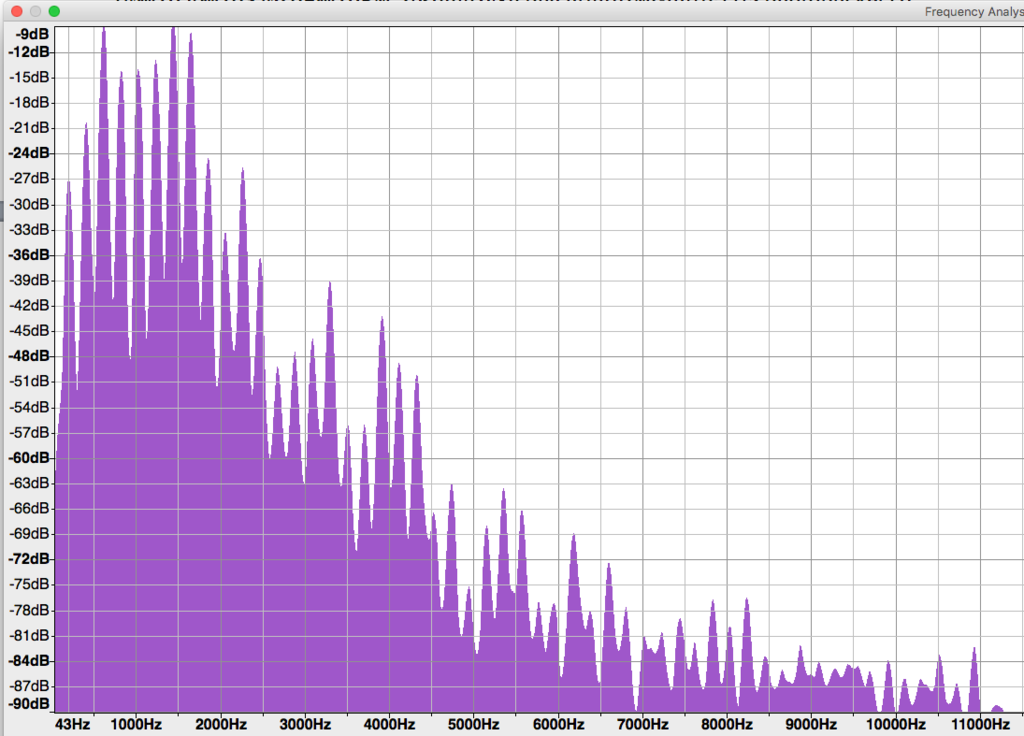
_________________
Derek Reaban
Tempe, Arizona
Tempe Winds / Symphony of the Southwest |
|
| Back to top |
|
 |
RichardCampbell
New Member
Joined: 17 Aug 2016
Posts: 8
Location: Huntsville Alabama
|
 Posted: Sat Aug 20, 2016 5:07 am Post subject: Posted: Sat Aug 20, 2016 5:07 am Post subject: |
 |
|
Richard Campbell Low Bb (mf)
1982 LA Benge 3X MLP with Warburton 5M/5 (Top/Backbore)
208 Hz (G#3) = -34dB
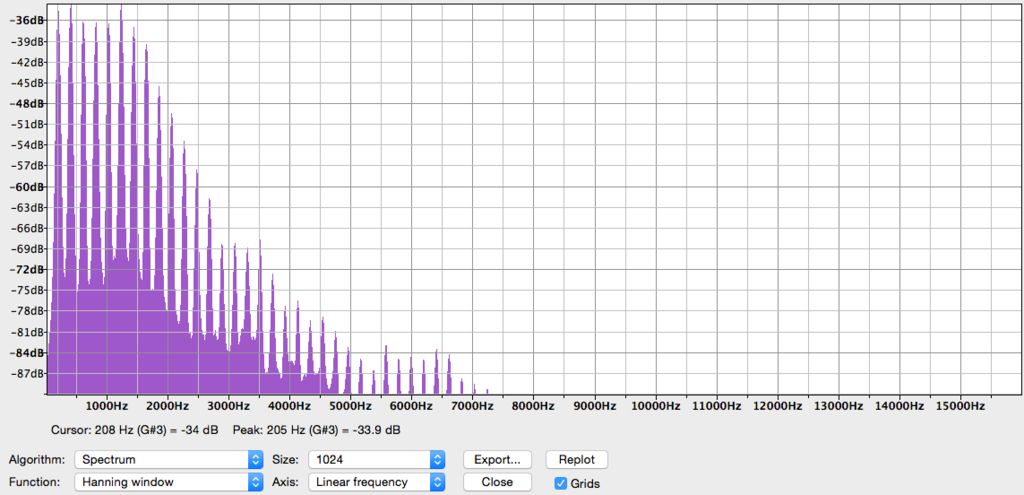 |
|
| Back to top |
|
 |
bach_again
Heavyweight Member

Joined: 03 Apr 2005
Posts: 2479
Location: Northern Ireland
|
|
| Back to top |
|
 |
Derek Reaban
Heavyweight Member

Joined: 08 Jul 2003
Posts: 4221
Location: Tempe, Arizona
|
 Posted: Sat Aug 20, 2016 6:12 am Post subject: Posted: Sat Aug 20, 2016 6:12 am Post subject: |
 |
|
Mike,
It took me a long time to finally decide on the Low Bb. I originally thought I would go with Low C, but I had a really hard time finding good recorded examples of Low C by orchestral players playing alone.
For the benchmark part of this project I will be showing three octaves of Bb. The last two notes of the opening to Mahler 5 are a printed Bb. There is no shortage of great recorded examples of Mahler 5 online, and we will be able to see the sonic signatures of some really great players on this note. And at different dynamics based on the final decrescendo. For the Bb at the top of the staff, Tchaikovsky Symphony 4 (printed Eb for F trumpet) will simply amaze everyone with the rich spectrum of overtones at a very strong dynamic
Thanks for asking.
_________________
Derek Reaban
Tempe, Arizona
Tempe Winds / Symphony of the Southwest |
|
| Back to top |
|
 |
bach_again
Heavyweight Member

Joined: 03 Apr 2005
Posts: 2479
Location: Northern Ireland
|
 Posted: Sat Aug 20, 2016 8:10 am Post subject: Posted: Sat Aug 20, 2016 8:10 am Post subject: |
 |
|
| Derek Reaban wrote: | Mike,
It took me a long time to finally decide on the Low Bb. I originally thought I would go with Low C, but I had a really hard time finding good recorded examples of Low C by orchestral players playing alone.
For the benchmark part of this project I will be showing three octaves of Bb. The last two notes of the opening to Mahler 5 are a printed Bb. There is no shortage of great recorded examples of Mahler 5 online, and we will be able to see the sonic signatures of some really great players on this note. And at different dynamics based on the final decrescendo. For the Bb at the top of the staff, Tchaikovsky Symphony 4 (printed Eb for F trumpet) will simply amaze everyone with the rich spectrum of overtones at a very strong dynamic
Thanks for asking. |
I had figured you had reasoning behind this, that makes perfect sense, thanks!!
_________________
Maestro Arturo Sandoval on Barkley Microphones!
https://youtu.be/iLVMRvw5RRk
Michael Barkley Quartet - Portals:
https://michaelbarkley.bandcamp.com/album/portals
The best movie trumpet solo?
https://youtu.be/OnCnTA6toMU |
|
| Back to top |
|
 |
beagle
Veteran Member

Joined: 18 Dec 2006
Posts: 419
Location: Vienna, Austria
|
 Posted: Sat Aug 27, 2016 6:31 am Post subject: Posted: Sat Aug 27, 2016 6:31 am Post subject: |
 |
|
Here's mine using my Selmer Chorus 80J.
Rob
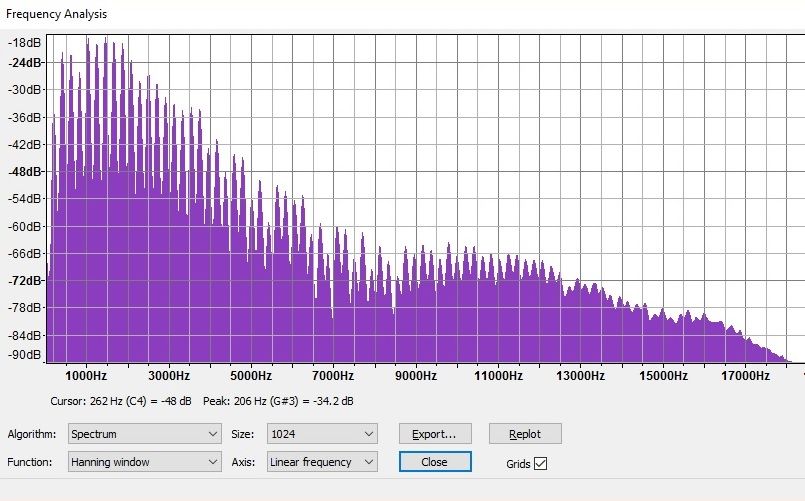
_________________
Schagerl Sig. James Morrison
Selmer Paris Chorus 80J |
|
| Back to top |
|
 |
beagle
Veteran Member

Joined: 18 Dec 2006
Posts: 419
Location: Vienna, Austria
|
 Posted: Mon Aug 29, 2016 12:21 pm Post subject: Posted: Mon Aug 29, 2016 12:21 pm Post subject: |
 |
|
Here's something quite interesting for this study. I discovered I had an old recording of myself practising long tones and luckily a low Bb was among them. At the time of the recording I had only three years of playing experience, though the horn and mouthpiece were the same (Selmer Chorus 80J with Bach 3C). Even the recording device is the same, though the room is different and I've no idea whether I was closer to or further from the mic.
My old plot (below) shows just 3 overtones stronger than the fundamental and one about the same level.
My current plot (above) has 17 overtones stronger than the fundamental which would indicate a massive improvement in tone if the hypothesis of the study is valid. I certainly hope I sound better now than I did back then.
For comparison with other plots, I'd rank myself as a strong intermediate level player and have been playing for 11 years (with a couple of years break in the middle when my daughter was born and we switched continents).
Regards,
Rob
Here's the old plot:
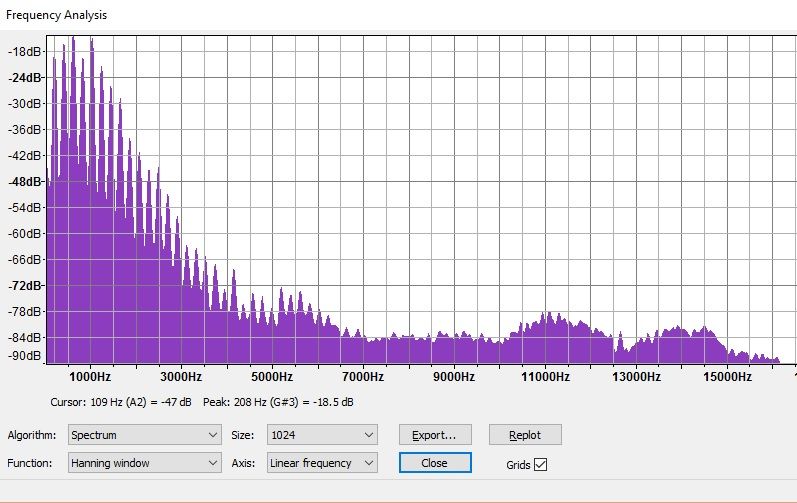
_________________
Schagerl Sig. James Morrison
Selmer Paris Chorus 80J |
|
| Back to top |
|
 |
Derek Reaban
Heavyweight Member

Joined: 08 Jul 2003
Posts: 4221
Location: Tempe, Arizona
|
 Posted: Tue Aug 30, 2016 7:37 am Post subject: Posted: Tue Aug 30, 2016 7:37 am Post subject: |
 |
|
Rob,
Thanks very much for posting this. The whole point of this project is to raise a player’s awareness of how much vibrancy they have in their sound through a simple measurement. While I haven’t yet opened the Benchmark topic, I think my hypothesis will hold true (less strength in the fundamental and more content in the overtones up to the 2,000 – 5,000 Hz range represents a mature sound). If a player sees that they have less “trumpet content” in their sound than a pro on the same note, it will hopefully lead them find out how to improve in that area. A snapshot every month or so after doing targeted exercises to improve vibrancy and resonance will show incremental progress. The longer term comparison, like you have shown, should be validation that practicing the right things overtime maked a huge difference in the maturity in the sound (i.e. more strength in the higher overtones).
I really appreciate your participation in this project and this cool snapshot of your playing from years ago against a plot from today is what I’d like everyone to have in this folder to look back on in a year or so. If the player has incorporated the right exercises, and worked on the diligently, they should have an improvement in their plot. If not, as would be expected, the plot would be nearly identical and this might lead them to consider adding some targeted exercises!
Thanks again.
_________________
Derek Reaban
Tempe, Arizona
Tempe Winds / Symphony of the Southwest |
|
| Back to top |
|
 |
freud311
Veteran Member
Joined: 02 Aug 2004
Posts: 108
|
 Posted: Thu Sep 08, 2016 2:45 pm Post subject: Posted: Thu Sep 08, 2016 2:45 pm Post subject: |
 |
|
Gerasimos Skliros
Selmer C700 with Jim R. New R6M mouthpiece.
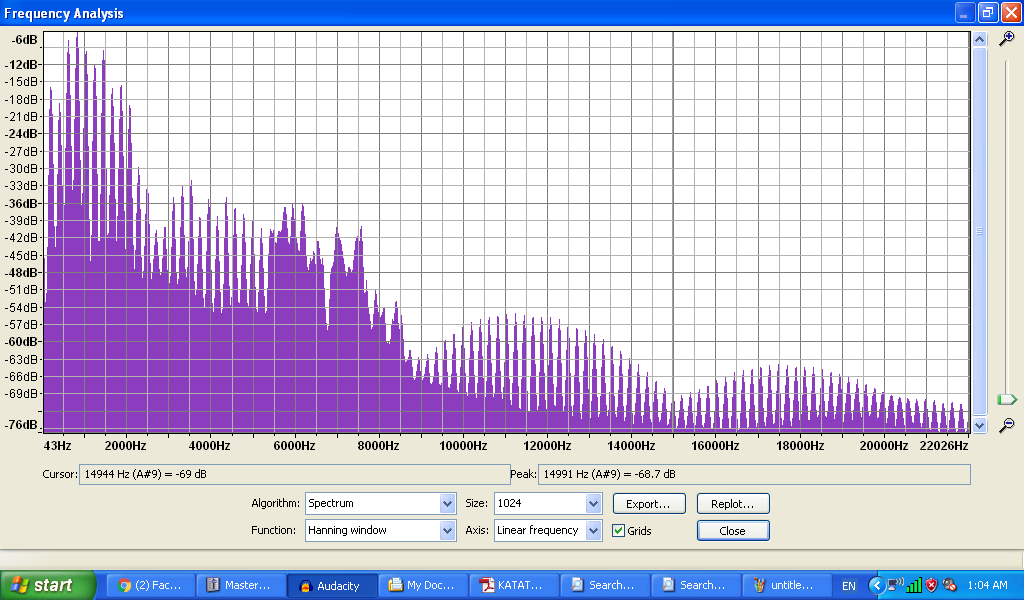 [/URL] [/URL]
This is not my main instrument... I left my instruments at work and I did that with my old Selmer..... Maybe my main C trumpet is more resonant...
My main problem all the 30 years I play is the projection. I Just started to use a spectrum analyser in my android tablet for a week now and I see results... I am very exited to this because I tried in the past to do it but I did not knew how to use or read the plot. After reread all these post here from Derek and Pops I know what I am looking for..... Thanks |
|
| Back to top |
|
 |
Derek Reaban
Heavyweight Member

Joined: 08 Jul 2003
Posts: 4221
Location: Tempe, Arizona
|
 Posted: Fri Sep 09, 2016 7:22 am Post subject: Posted: Fri Sep 09, 2016 7:22 am Post subject: |
 |
|
freued311,
Thanks very much for posting your plot. Pops has lots of good content on his site and I’m glad that I was able to provide an explanation to make Spectral Analysis easier to understand. Once I get more “benchmark” plots completed, it will give us all an excellent feel for what different notes at different dynamics look like played by great players. Eventually I’ll get a “Comparison” folder opened and do a side by side analysis of my sound against the Benchmark players for the Low Bb, 3rd Line Bb, Bb above the staff and probably an F or G at the top of the staff at different dynamics. This will show how Spectral Analysis can be used to identify target areas where exercises can be added to enhance vibrancy. Then I’ll open a “Best Practices” folder and we can all share how to make best use of this tool. We all know how a metronome and tuner work, but Spectral Analysis is new for everyone. A discussion on this new technology would be good for teachers and those of us that want to use it on our own.
Thanks again for sharing the picture of your sound!
On another note, I was in Athens two summers ago while on a Mediterranean cruise and had a great day exploring the city with my family. The views at the Acropolis made the World History books I’ve seen all my life simply come alive. What an amazing city!
_________________
Derek Reaban
Tempe, Arizona
Tempe Winds / Symphony of the Southwest |
|
| Back to top |
|
 |
Jim-Wilson
Veteran Member
Joined: 11 Oct 2005
Posts: 415
Location: Fort Smith, AR
|
 Posted: Tue Jun 12, 2018 2:23 pm Post subject: Complexity of Sound Posted: Tue Jun 12, 2018 2:23 pm Post subject: Complexity of Sound |
 |
|
Derek and others,
I've been away from TH for some time but thought you all might be interested in this video that explores the complexity of sound that goes way beyond what we visualize with equipment like Audacity.
To get the whole implication of this I would encourage watching the whole video. Most of you will find it quite fascinating and revealing.
https://www.youtube.com/watch?v=uMK3OVBjx2Q
Jim |
|
| Back to top |
|
 |
lipshurt
Heavyweight Member
Joined: 24 Feb 2008
Posts: 2642
Location: vista ca
|
 Posted: Tue Jun 12, 2018 3:07 pm Post subject: Posted: Tue Jun 12, 2018 3:07 pm Post subject: |
 |
|
Those plots look incorrect to me. They show comb filtering. A trumpet plot should look a lot different than that. Comb filtering is when there is cancelation every x number of cycles per second. These plots for sure show comb filtering. Caused by phasing issues usually from two microphones, but could also be caused by (I suppose) early reflections.
_________________
Mouthpiece Maker
vintage Trumpet design enthusiast
www.meeuwsenmouthpieces.com
www.youtube.com/lipshurt |
|
| Back to top |
|
 |
Don Herman rev2
'Chicago School' Forum Moderator
Joined: 03 May 2005
Posts: 8951
Location: Monument, CO
|
 Posted: Tue Jun 12, 2018 3:42 pm Post subject: Posted: Tue Jun 12, 2018 3:42 pm Post subject: |
 |
|
The trumpet is a resonant system so I would expect that sort of response. Not comb filtering per se, but the result of resonant peaks and nulls (anti-nodes and nodes) at key harmonic'ish frequencies.
_________________
"After silence, that which best expresses the inexpressible, is music" - Aldous Huxley |
|
| Back to top |
|
 |
|